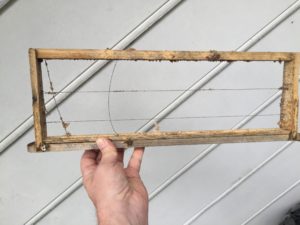A new beekeeper swung by to watch some of my misadventures in the bee yards and started off asking me what all the numbers on the frames were. At one end of an open hive, each frame has a number, right now ranging from 10 to 17. These numbers serve two purposes – primarily, they tell me the year that the frame went into production. “12” means that this frame “went live” in 2012. The wax is about that old and it helps me to identify which frames go to the wax melter each year (and are then filled with fresh foundation). I start removing frames in year 5 and absolutely have them recycled by year 10. The numbers also tell me the direction the frame is in – it helps me keep them oriented in the same direction they were before I started a deep inspection.

The next question the new beekeeper asked was about the wires that ran horizontally through the frame. That observation caused even me to pause and look at the frame. As noted back in 2012 (posted here), I have long since stopped wiring my frames. It has been so long that I never even think about it anymore (and I have long since recycled nearly all frames with this wire).
When I started beekeeping, everyone told me you had to run a wire through the frame horizontally. This would prevent the drawn wax from falling out of the frame on hot days. I dutifully (one could call it blindly:) followed their instructions and wired all of my frames, both Deeps and Mediums. All was good!
My beekeeping hives continued to expand and I was soon creating tons of new frames. This was taking a huge amount of time, so I purchased a frame jig and started using a nail gun. Bingo! Huge time savers! I experimented with different frame types and this cut even more time. Soon, the lion’s share of my time, for each frame, was spent wiring the daggone things. No matter where I looked, I found no easy (faster) solution to this. Finally, it dawned on me. Did I really need to wire these things? If ever there was something to experiment with, this was it. So, I started small – maybe 10 hives without wires. Let’s see what happened.
I am happy to report that I have not created a wired frame since 2013 and have not had a single instance of wax falling out of my frames. I do have wire embedded (vertically) in the foundation that I purchase and feel confident that this is the real reason that my drawn wax remains secure. I have only recently started to attend some of the local beekeeping association meetings again, so am unsure if “wiring” is still suggested to new beekeepers. I can only speak from my experience – wiring hives may have been a must have in the past, but they are no longer necessary for me.

Reader Comments
I am in need of a queen or a queen cell. If you can help please email me.
Thank you
Although I do occasionally run across queen cells, it would be impossible for me to coordinate getting one to you. Sorry – life is crazy these days!
Just starting this year, any advice would be appreciated.
I think the main advice that I have for any new beekeeper is to make sure they talk to several experienced beekeepers about starting out. When I started, I found that there are many ways to skin a cat in beekeeping and experienced beekeepers often have widely differing ways on how they keep their bees. It was very useful to me to absorb all of this advice, sometimes contradicting, as I made my way through the early stages. To best address, locate two beekeeping clubs nearby (https://virginiabeekeepers.org/local-groups/local-groups-map) and start attending their monthly meetings.
Coupled with this, I would consume literature (online or otherwise) from Michael Bush and Michael Palmer. My beekeeping is really based on their experiences and I have found them to be the two best sources on just plain, practical beekeeping.